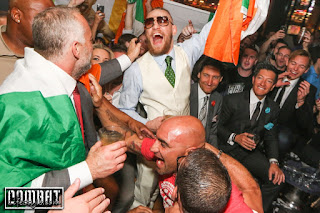 |
| Ricardo Libório imparting his knowledge |
There are names that are spoken of in hushed tones in gyms where men and women learn what it means to not give up. Brazilian jiu jitsu has its heroes; athletes who ascend to the pinnacle of the competition circuit or transition successfully into mixed martial arts. Their names are invoked in casual conversation when discussing how to set up a new technique or execute a match-ending submission.
But there is a still higher pantheon of jiu jitsu masters. Their feats are near mythical and their abilities merge with their personas to cast a larger than life shadow across the whole of the sport. American Top Team founder Ricardo Libório is such a man.
Libório began his jiu jitsu career under the tutelage of the great Carlson Gracie, son of the founder of Gracie jiu jitsu. Due to his childhood background in judo and his facility for grasping techniques quickly, Libório became one of Carlson’s prize students. His reputation quickly spread as one of Carlson’s fiercest competitors in all of Brazil. Very early in his career, Libório was talked about by his trainer and many of his peers as possibly the greatest of his generation. At the inaugural Brazilian jiu jitsu World Championships in 1996, Libório entered two weight classes above his usual division and dismantled the competition. He captured a gold medal in the 100 kg weight class, closed out the open weight division with his teammate Amaury Bitteti and was voted most technical competitor.
As Carlson's focus shifted increasingly to MMA in the mid-90s, Libório became one of the main instructors at the academy. He continued his competition success at the World Submission Wrestling Championships hosted by the Abu Dhabi Combat Club, taking third place in 1999 and second in 2000. The legend of his otherworldly skills only grew during this period as Libório would disappear from the academy for weeks or months at a time due to a full time job at a Brazilian bank. According to lore, he would come in on lunch breaks, change his clothes and tear through some of the toughest fighters in the world in minutes before re-robing and heading back to the office.
Following a schism with his trainer, Libório went on to found the Rio Jiu Jitsu Club and then later the Brazilian Top Team (BTT) with his old teammates. He became the primary jiu jitsu instructor at BTT, developing the grappling game of their MMA fighters while helping coach jiu jitsu competitors such as Fernando Margarida Pontes and Ricardo Arona to World Championships.
In 2002, Libório decided to pursue new opportunities in the United States, opening the American Top Team (ATT) with Dan Lambert and Marcus and Marcelo Silveira in Coconut Creek, Florida. Immediately upon arriving, Libório set about infusing the academy with his character of openness and always being willing to lend a hand to someone in need. Fighters dropping into ATT to train with the fabled master were shocked to meet such an affable gentleman capable of making them feel so helpless in training. His merciless pressure and technical precision on the mat became part of modern jiu jitsu folklore as high level competitors left training sessions doubting everything they ever knew about the art.
Not content to keep his knowledge bottled up, ATT expanded and Libório began spreading jiu jitsu and mixed martial arts knowledge through his students’ academies. Over the years, Libório has trained a who’s who of mixed martial arts champions, including UFC Welterweight Champion Robbie Lawler, Bellator Champions Will Brooks, Douglas Lima, Daniel Straus and Hector Lombard, WEC Champion Mike Brown, Sengoku Champion Jorge Santiago and WSOF Champion Jessica Aguilar. He has also trained grappling and jiu jitsu world champions such as Jeff Monson and Marcelo Garcia. In 2009, he was named the head coach of FILA’s US Grappling team where he successfully led the team to a gold medal in gi competition at the World Championships.
Shortly after the birth of his daughter Bella, jiu jitsu would come to take on a whole new meaning for Libório. When she was just a toddler, Bella was diagnosed with a cranial ailment that caused her to lose her eyesight. Following a harrowing ordeal of surgeries and rehabilitation, her father turned to the art that had defined his life to give his daughter an extra set of tools to interact with the world around her. Drawing on a mastery of the art few on earth have attained, Libório devised a methodology for teaching Bella jiu jitsu, focusing on vivid verbal descriptions and the close contact that characterizes the sport. After realizing success, Libório did what he’s always done: spread his knowledge to as many people as he could. He has since pioneered a special jiu jitsu program for blind children and made ATT one of the largest gyms in the US to cater specifically to paralympic combat athletes.
In the often ego driven world of fight sports, it can be a challenge to find someone who balances near superhuman abilities to impose their will with unrelenting generosity and kindness of spirit. Competitive or commercial success can draw anyone down the path of believing their own hype and becoming unapproachable and withdrawn. But those who have met him will testify that the mythical status Ricardo Libório enjoys is tempered by the fact that he is so adept at simply being a man.




















